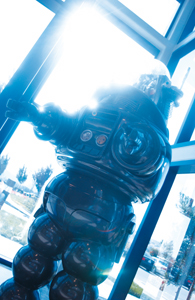![[Metroactive Features]](http://metroactive.com/features/gifs/feat468.gif)
[ Features Index | Silicon Valley | Metroactive Home | Archives ]
Metro's 20th Anniversary
Blinded by Science
Silicon Valley has a reputation as the home of the cutting-edge scientific innovatiors. But what have they done for us lately?
By Najeeb Hasan
Finding real science in Silicon Valley is tougher than you'd think. There are plenty of ideas for making money, but new ways to sell the same old stuff does not always pass for innovation.
However, there's no denying that Silicon Valley has changed the way human beings live their lives. In 1997, local historian John McLaughlin and the late Peninsula Times Tribune editor Ward Winslow came out with the documentary, Silicon Valley: A 100 Year Renaissance. The two famously compared Steve Jobs and Steve Wozniak and their personal computer to Gutenberg's printing press from the 15th century. More importantly, they traced Silicon Valley's emergence as a scientific powerhouse to the founding of Stanford University in 1885.
But what about the last 20 years? What's Silicon Valley done to be true to its edgy image?
[ Silicon Valley | Metroactive Home | Archives ]
Copyright © Metro Publishing Inc. Metroactive is affiliated with the Boulevards Network.
For more information about the San Jose/Silicon Valley area, visit sanjose.com.
![]()
![[line]](/gifs/line.gif)
20 Years of News: Thanks, Silicon Valley, for being news to us.
Sub-Urban: For 20 years, San Jose's downtown has grown in everything but stature. What's it going to take to get a little respect?
Lost Roots: In the last 20 years, Silicon Valley has finally realized that it needs to preserve its agricultural heritage—in museums. Meanwhile, land that could be saved is being marked for development.
Tech Will Eat Itself: Boom! Bust! Boom? Drink this Kool-Aid to remember the wacky and possibly circular history of Silicon Valley high tech in the last 20 years.
Blinded by Science: Silicon Valley has a reputation as the home of the cutting-edge scientific innovatiors. But what have they done for us lately?
![[line]](/gifs/line.gif)

Robo Crop: While science-fiction films went bigger and bigger with fictional technology, Silicon Valley's innovators went smaller and smaller with the real thing. This statue of Robby the Robot stands in the lobby of Alien Technology, who are themselves known for some controversial creativity—namely Radio Frequency Identification, which Metro wrote about last year.
Send a letter to the editor about this story to letters@metronews.com.
From the March 9-15, 2005 issue of Metro, Silicon Valley's Weekly Newspaper.